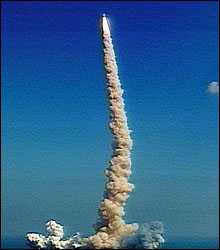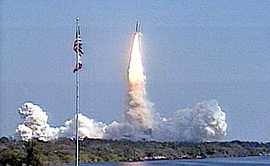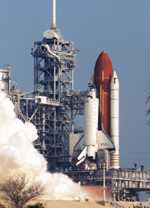The last year of service by the U.S. space shuttle fleet before Columbia was lost on February 1, 2003
 Shuttle Endeavour Launch Feb. 11, 2000 |
Some of the 2001 flights were among the most challenging in shuttle history. The complexity of missions continued in 2002.
Columbia. The year 2002 was marked by the return to space of the shuttle fleet matriarch Columbia. It made the first non-space-station shuttle flight in more than two years.
Discovery. Shuttle Discovery remained on the ground in 2002 for standard maintenance and inspections.
Atlantis and Endeavour. Flights by shuttles Atlantis and Endeavour continued the expansion of the International Space Station.
Space Station. During 2002, the American shuttle fleet added more than 50 tons of additional components to the space station. The shuttles also serviced the Hubble Space Telescope and conduct an extended research mission.
Space Walks. While spacewalks may not be considered routine activities for some time, they continued to become more common in 2002.
- In 2001, 18 spacewalks were conducted -- 12 from shuttles and six from the space station. That was the most, by far, of any year to date.
- In 2002, NASA broke the record set in 2001 for the most spacewalks conducted in a single year. From space shuttles alone, 15 spacewalks are planned in 2002. Coupled with seven spacewalks that are planned by crews from the International Space Station, the record for annual spacewalks was shattered.
Technology Experiments. During 2002, the shuttle fleet carried more than three dozen new experiments to the International Space Station and two new laboratory experiment racks.
Hubble Repair. Columbia is to be the first 2002 shuttle mission with a flight STS-109 to service the Hubble Space Telescope. It is to be the fourth mission to service the space telescope since its launch in 1990.
Five spacewalks were conducted during the service flight to install an advanced new camera system, attempt to reactivate an existing infrared instrument system, install new solar arrays and install a new power controller. The mission extended the lifetime and capabilities of the famous orbiting telescope.
 Shuttle Endeavour Launch |
Glass Cockpit. When Columbia launched, it was the second shuttle to fly with NASA's new "glass cockpit." It was installed as part of maintenance and modifications of Columbia completed in 2001. On flight STS-101 in May 2000, Atlantis was the first shuttle orbiter to fly with the new cockpit.
The glass cockpit has 11 full-color, flat-panel displays that replace 32 gauges and electromechanical instruments and four cathode-ray tube monitors in the old cockpit. The new cockpit is lighter, uses less power and sets the stage for a future "smart cockpit" for the shuttle. That cockpit featured more intuitive displays to reduce pilot workload during critical periods.
Station Trusses. In Spring 2002, Atlantis lifted off on flight STS-110, the second mission of the year, to continue the shuttle fleet's expansion of the space station.
Atlantis delivered the first of three giant truss segments to be launched during 2002. The first truss became the center segment of a cross-beam more than 300 feet long. The cross-beam supports solar arrays, radiators and external experiments.
Mobile Transporter. Atlantis also ferried a mobile transporter, the first part of a system that provides a mobile base for the station's robotic arm to allow it to move up and down that football-field-long truss. Four spacewalks were needed from Atlantis crew to install the new station components. STS-110 was one of the most complex space station flights of the year.
Logistics Module. Endeavour is scheduled to launch later in Spring 2002 on flight STS-111 carrying a fifth resident crew to the space station as well as the Leonardo logistics module filled with experiments and supplies.
 Space Shuttle Launch |
Microgravity Science. Columbia flight STS-107 in Summer 2002 was an international mission dedicated to microgravity science. The shuttle carried a double Spacehab module filled with 32 experiments involving 59 separate investigations.
FREESTAR. A suite of eight additional investigations in Columbia's payload bay, together called FREESTAR, included studies ranging from fluid physics to a student satellite.
The mission's scientific work involved the fields of materials science, combustion, fundamental physics and biology. The mission was an extended flight with a duration of 16 days.
Starboard Truss. In late summer, expansion of the International Space Station continued as Atlantis makes its second visit of the year to the complex during flight STS-111. The shuttle carried the first starboard side truss segment to be attached to the end of the central segment delivered back in March. The connections were finalized during two spacewalks.
Port Side Truss. The final mission of 2002 saw Endeavour visit the station again in the fall, attaching a port side truss segment to the station. That completed almost half the length of the 300-ft. truss. Two spacewalks were performed to connect the new truss segment. The truss measured about 133 feet long by the end of 2002.
Endeavour also delivered the sixth resident crew to the station.